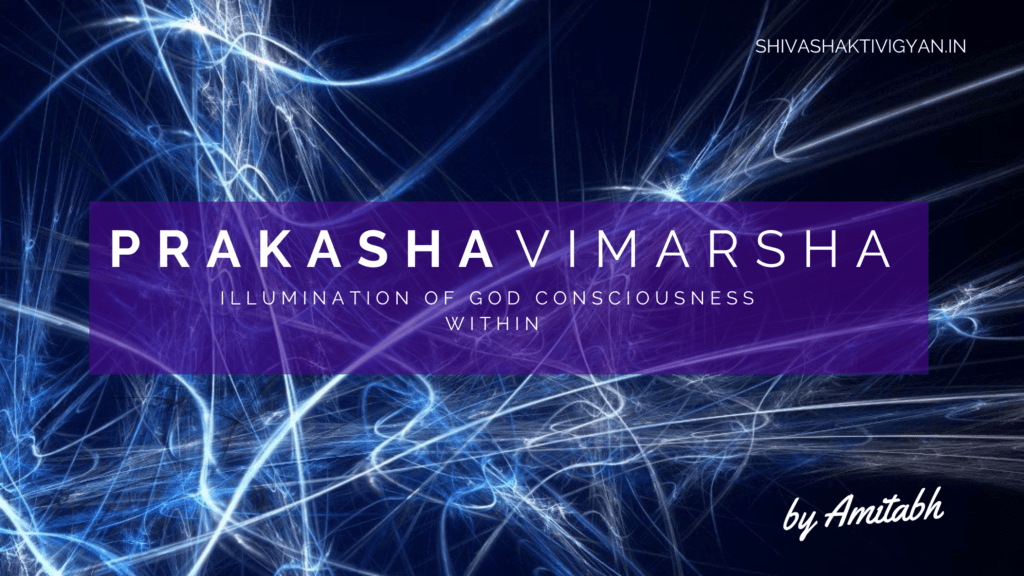
Introduction:
Trika Tantra, the esoteric non-dual Shaivism of Kashmir, unfurls a profound philosophical tapestry woven with the threads of two fundamental principles: Prakāśa and Vimarśa. These principles, representing the luminous awareness and the reflective self-awareness respectively, are not mere theoretical constructs but the living forces that animate both individual consciousness and the cosmic reality. This essay aims to delve deeper into the intricate relationship between Prakāśa and Vimarśa, drawing upon the rich wisdom enshrined in the essential texts of Trika Tantra.
Prakāśa: The Illuminating Awareness:
Prakāśa, the Sanskrit term for “light” or “illumination,” signifies the self-luminous awareness that forms the very substratum of consciousness. It is the pure subjectivity, the witness that underlies all thoughts, emotions, and perceptions. As the Vijñāna Bhairava succinctly puts it:
“Prakāśa is the light of consciousness, the witness of all that is.”
This illuminating awareness is not a passive observer but the dynamic source of all creation and manifestation. It is the wellspring of knowledge, creativity, and bliss, the supreme power that pervades the entire universe. The Mālinī Vijaya Tantra extols the glory of Prakāśa:
“Prakāśa is the supreme power, the creator of all worlds, the illuminator of all beings.”
Vimarśa: The Reflective Self-Awareness:
Vimarśa, meaning “reflection” or “self-awareness,” denotes the dynamic aspect of consciousness that engages with the world of objects and experiences. It is the power of consciousness to turn back upon itself, to reflect upon its own nature and activities. The Tantrāloka of Abhinavagupta, the celebrated exponent of Trika philosophy, defines Vimarśa as:
“Vimarśa is the power of self-reflection, the source of all creation, the dynamic energy of consciousness.”
Vimarśa is not separate from Prakāśa but its dynamic expression, the pulsating energy that animates the static awareness. It is through Vimarśa that the pure consciousness of Prakāśa becomes self-aware and interacts with the world. The Spanda Kārikā, a key text on the Spanda school of Kashmir Shaivism, beautifully captures this dynamic interplay:
“Vimarśa is the pulsation of consciousness, the vibration that gives rise to all forms and experiences.”
The Interplay of Prakāśa and Vimarśa:
Trika Tantra emphasizes the inseparable nature of Prakāśa and Vimarśa. They are not two distinct entities but two facets of the same reality, like the two sides of a coin. Prakāśa is the static, unchanging awareness, while Vimarśa is the dynamic, ever-changing self-awareness. The Pratyabhijñā Hṛdaya, a foundational text of Kashmir Shaivism, articulates this profound truth:
“Prakāśa is the light that shines forth, Vimarśa is the power that reflects. Together they create the universe and all that is within it.”
This dynamic interplay of Prakāśa and Vimarśa is the very foundation of creation, sustenance, and dissolution of the universe. It is also reflected in the microcosm of individual consciousness, where the constant fluctuation of thoughts, emotions, and perceptions is the result of the interplay of these two fundamental principles.
The Significance of Prakāśa and Vimarśa in Liberation:
The ultimate goal of Trika Tantra is liberation, the recognition of our true nature as pure consciousness. This realization involves transcending the limitations of the ego and merging with the universal consciousness, a state known as moksha or liberation. The Shiva Sutras, a revered scripture of Kashmir Shaivism, proclaims:
“When the individual consciousness merges with the universal consciousness, liberation is attained.”
This merger is not an annihilation of individual consciousness but its expansion into the infinite awareness of Prakāśa. It is the realization of our true identity as the self-luminous, ever-blissful consciousness that pervades the entire universe.
Conclusion:
The principles of Prakāśa and Vimarśa offer a profound framework for understanding the nature of reality, consciousness, and liberation. Their dynamic interplay is the very essence of existence, the creative force that manifests the universe and all that is within it. By recognizing the non-dual nature of these two principles within our own consciousness, we can transcend the limitations of the ego and attain the ultimate freedom.
Love Light and grace
Amitabh
